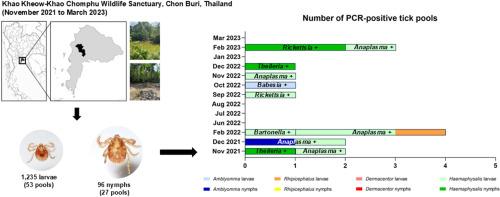Diversity of questing ticks and prevalence of tick-associated pathogens in Khao Kheow-Khao Chomphu Wildlife Sanctuary, Chon Buri, Thailand
IF 1.7
Q3 PARASITOLOGY
Current research in parasitology & vector-borne diseases
Pub Date : 2024-01-01
DOI:10.1016/j.crpvbd.2024.100220
引用次数: 0
Abstract
Ixodid ticks are important vectors for tick-borne diseases distributed worldwide, including Thailand. Recreation areas within wildlife habitats are considered high-risk zones for tick exposure and tick-borne disease in humans. The study aimed to determine seasonal variations in tick diversity and pathogen prevalence in Khao Kheow-Khao Chomphu Wildlife Sanctuary, Chon Buri, Thailand. From November 2021 to March 2023, a total of 1331 immature ticks were collected by dragging. The proportion of collected larvae was highest in February 2022, while the number of collected nymphs peaked in December 2021. Seven tick species were molecularly identified: Haemaphysalis lagrangei, H. wellingtoni, H. shimoga, H. obesa, Dermacentor auratus, Rhipicephalus microplus, and Amblyomma integrum. Of 80 tick pools, Anaplasma, piroplasms (Babesia and Theileria), Bartonella, and Rickettsia were detected in 10% (8/80), 3.75% (3/80), 1.25% (1/80), and 3.75% (3/80) of tick pools, respectively. Phylogenetic analysis grouped the newly generated sequences in the clades of Anaplasma bovis, Babesia gibsoni, Theileria cervi, Bartonella henselae, and Rickettsia montanensis. A seasonal pattern of pathogen appearance was detected during November to February, the cool season in Thailand. Based on our results indicating the highest peak of immature ticks and prevalence of pathogens, visitors should take precautions to avoid tick exposure during this season.

泰国春武里府 Khao Kheow-Khao Chomphu 野生动物保护区的蜱虫多样性和蜱虫相关病原体的流行情况
蜱虫是蜱传疾病的重要传播媒介,分布于包括泰国在内的世界各地。野生动物栖息地内的休闲区被认为是人类接触蜱虫和蜱虫传播疾病的高风险区。该研究旨在确定泰国春武里府 Khao Kheow-Khao Chomphu 野生动物保护区内蜱虫多样性和病原体流行的季节性变化。从 2021 年 11 月到 2023 年 3 月,共拖曳收集了 1331 只未成熟蜱虫。采集到的幼虫比例在 2022 年 2 月最高,而采集到的若虫数量在 2021 年 12 月达到峰值。经分子鉴定,有 7 个蜱虫物种:Haemaphysalis lagrangei、H. wellingtoni、H. shimoga、H. obesa、Dermacentor auratus、Rhipicephalus microplus 和 Amblyomma integrum。在 80 个蜱池中,分别有 10%(8/80)、3.75%(3/80)、1.25%(1/80)和 3.75%(3/80)的蜱池检测到阿纳普拉斯菌、螺旋体(巴贝斯菌和泰勒菌)、巴顿氏菌和立克次体。系统发育分析将新产生的序列归入牛鼻疽、吉布森巴贝斯虫、宫颈糜烂丝虫、鸡沙门氏菌和黑山立克次体的支系。11 月至次年 2 月是泰国的冷季,在此期间发现了病原体出现的季节性模式。我们的研究结果表明,这个季节是未成熟蜱虫和病原体出现的最高峰,因此游客应采取预防措施,避免接触蜱虫。
本文章由计算机程序翻译,如有差异,请以英文原文为准。
求助全文
约1分钟内获得全文
求助全文

 求助内容:
求助内容: 应助结果提醒方式:
应助结果提醒方式:


